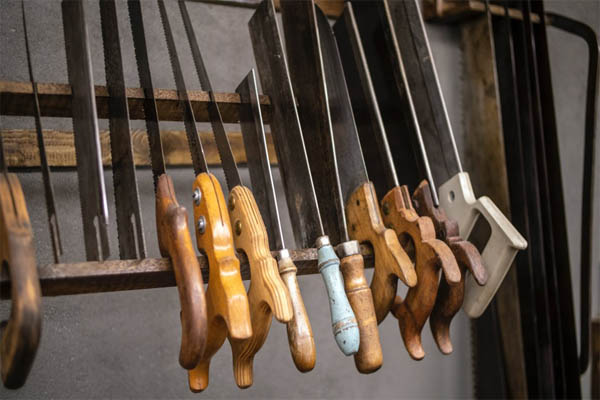History and Evolution of Handsaws: Tracing the Journey of a Timeless Tool
In the world of woodworking, where creativity meets craftsmanship, few tools are as emblematic as the handsaw.
This guide delves into the intriguing history and evolution of handsaws, tracing their origins from ancient times to the modern era.
From their primitive beginnings to their contemporary designs, handsaws have not only shaped woodworking practices but also left an indelible mark on culture, art, and craftsmanship.
Ancient Origins of Handsaws
The roots of handsaws can be traced back to the dawn of civilization:
- Early Sawing Tools: The earliest forms of sawing tools were crude instruments with serrated edges, often crafted from shells or sharpened stones.
- Archaeological Discoveries: Archaeological findings reveal evidence of ancient saws in various cultures, providing insight into early sawing techniques.
- Primitive Designs: These early handsaws were characterized by simple materials and designs, marking the very beginnings of sawing technology.
Medieval and Renaissance Advances
The Middle Ages and the Renaissance brought significant advancements to handsaw technology:
- Transition to Straight-Tooth Saws: During this era, the transition from serrated edges to straight-tooth saws marked a pivotal shift in sawing efficiency and precision.
- Woodworking Guilds and Specialization: The growth of woodworking guilds led to the specialization of handsaw production, resulting in improved craftsmanship and diversity of designs.
- Emergence of Frame Saws and Panel Saws: The medieval period saw the rise of frame saws for intricate work and panel saws for larger tasks, revolutionizing woodworking possibilities.
Industrial Revolution: Mechanization and Innovation
The Industrial Revolution heralded mechanization and innovation in handsaw production:
- Steam-Powered Machinery: With the introduction of steam power, the manufacturing process of handsaws was mechanized, increasing efficiency and output.
- Mass Production Impact: Mass production techniques enabled handsaws to become more accessible, leading to a proliferation of woodworking tools.
- Advancements in Metallurgy: Innovations in metallurgy resulted in higher-quality blades, enhancing the cutting performance and longevity of handsaws.
19th and 20th Century Innovations
The 19th and 20th centuries brought about remarkable innovations in handsaw design and technology:
- Introduction of the Back Saw: The back saw, characterized by a stiffening rib along the edge opposite the cutting edge, enabled more precise cuts for joinery and finer work.
- Development of the Circular Saw: The invention of the circular saw revolutionized construction, allowing for efficient and rapid cutting of large timber.
- Rise of Power Tools: The 20th century witnessed the rise of power tools, impacting handsaw usage by introducing efficiency and automation into woodworking practices.
Contemporary Handsaw Design
The evolution of handsaw design has continued into the modern era:
- Ergonomic Advancements: Contemporary handsaws feature ergonomic designs for user comfort and reduced fatigue during prolonged use.
- Modern Materials Integration: Handsaw construction now incorporates modern materials such as composites and alloys to enhance durability and performance.
- Persistence of Traditional Designs: Despite modernizations, traditional handsaw designs endure, catering to those who appreciate the craftsmanship of the past.
Specialized Handsaws
The evolution of handsaws led to the creation of specialized tools for specific tasks:
- Dovetail Saws and Coping Saws: Specialty saws like dovetail saws for intricate joinery and coping saws for curved cuts offer woodworkers more precision and versatility.
- Role in Modern Woodworking: These specialized handsaws cater to the demands of modern woodworking, allowing artisans to achieve intricate details and complex cuts.
In addition to these specialized saws, modern woodworking has seen the emergence of innovative handsaws, including the handsaw for cutting trees, which has revolutionized the way woodworkers tackle larger projects.
Cultural and Artistic Significance
Handsaws transcend mere utility and hold cultural and artistic significance:
- Cultural Symbolism and Artistry: Handsaws have been used as symbols of hard work, craftsmanship, and diligence in various cultures.
- Representation in Literature and Visual Arts: Literature and visual arts have often depicted handsaws as tools that shape characters and narratives, highlighting their cultural resonance.
- Legacy in Craftsmanship: The legacy of handsaws persists as a testament to the skill and dedication of craftsmen throughout history.
Preservation and Collecting
The appreciation for handsaws extends to collectors and enthusiasts:
- Rise of Collectors: Collectors and enthusiasts now preserve antique handsaws, valuing them as artifacts of woodworking history.
- Restoration and Preservation: Restoration efforts ensure that antique handsaws are not only preserved but also functional, allowing future generations to appreciate their craftsmanship.
- Handsaws as Historical Artifacts: Handsaws serve as tangible links to woodworking practices of bygone eras, offering insights into the evolution of tools and techniques.
Conclusion
The history and evolution of handsaws serve as a testament to the ingenuity of human craftsmanship.
From their humble origins in ancient times to their transformation into precision tools of the modern age, handsaws have played an integral role in shaping woodworking practices and culture.
As you pick up a handsaw today, you wield a tool with a lineage that stretches across centuries, bridging the past and the present.
The journey of handsaws encompasses innovation, tradition, artistry, and utility, embodying the spirit of craftsmanship that continues to shape our world.

Don Kerr spent many years honing his skills as a DIY woodworker. He finds immense joy in not only creating remarkable pieces but also in generously sharing his knowledge. Connect with him via group.



